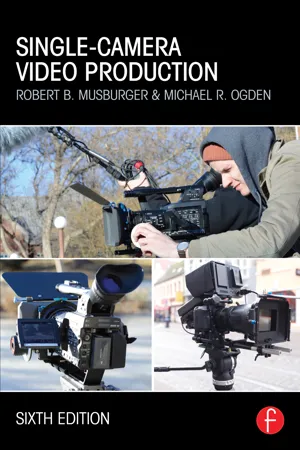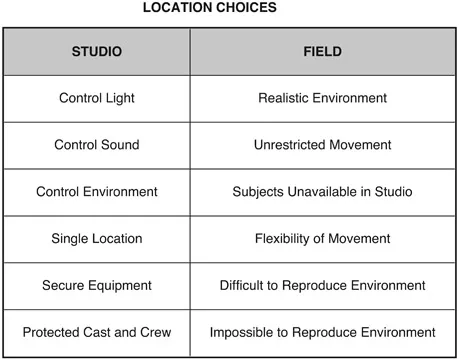![]()
Chapter One
Production Philosophy
The Production Process
Despite the general public’s attitude toward digital media production as a simple activity, in reality you will find that although digitizing has made the equipment lighter, smaller, more powerful, and full of technology that offers greater creativity to you as a producer, director, camera operator, or editor, the process actually has gotten more complex. When you replace controls and functions necessary to operate analog video and audio equipment with digital equipment, it appears to make operations simpler, and in some ways that has occurred. But the nature of digital technology and equipment provides you with a greater opportunity for more choices in operations. Those opportunities require you to meet a broader range of decisions, setting specific operational criteria for each shot or setup. You may point and shoot, but that alone is not professional. The increase of distribution systems available to your production include smart phones, tablets, streaming, and newer technologies that require care and consideration while planning, producing, and especially editing your final production.
To give you the best means to take advantage of all that digital equipment offers, this text is organized to lead you through the entire production process from beginning to end. The first step is to understand that production is actually a three-stage process: preproduction, production, and postproduction. The three stages are unique and separate to a point, but they are also dependent on each other for the success of the complete project—what you fail to account for in preproduction will impact what can be accomplished in production which will, in turn, effect what you can do in post-production which may result in a different product than was originally planned. Also, each of these stages of production is dependent on the final plans for distribution of the project. The three steps are equally important—without all three you will not be able to complete a professional production. Each step requires your thoughtful consideration of the aesthetic values of the entire production as well as each individual production choice (see Table. 1.1).
You will use the preproduction stage to prepare the production, organize and research your thoughts on what you want to do, and complete the many sets of written materials from proposals through completed scripts as well as a budget and production schedule.
TABLE 1.1 – Depending on the requirements of the individual production, the size of the crew, and the length of the production, some of the functions and operations of each of the three steps may be combined simultaneously.
SINGLE-CAMERA VIDEO PRODUCTION
THREE-STEP PRODUCTION PROCESS |
| PREPRODUCTION | PRODUCTION | POSTPRODUCTION |
Concept
Research
Planning | Organizing
Crew
Cast
Equipment | Acquisition
Organizing |
Proposal
Treatment
Budget
Storyboard | Constructing
Sets
Props
Communication
Prompting | Ingesting
Logging
Formatting |
Draft Script
Scene Script
Shot Script | Setting Up
Lights
Audio
Camera(s) | Rough Cut
Final Cut
Audio Mix |
Location Scouting
Site Survey
Plot Drafting | Rehearsal
Rough
Cast
Camera
Final | Effects
Color Correction
Audio Correction
Rendering |
Hiring
Crew
Cast
Equipment | Recording
Logging
Effects
Striking | Master
Release
Output |
During the production stage, before you actually start shooting, you still must perform some preparation steps before you remove the lens cap, turn on the microphone and record images and sounds. You must take as much care with logging and striking equipment as you did with setting up and shooting.
Once the images and sounds are recorded on tape, disc, or solid-state media, you then are faced with organizing the material again in the postproduction stage. Recorded images and sounds must be encoded into an editing system (usually computer-based and nonlinear), and you must choose the shots you want and trim them into a final form before adding music, visual or sound effects, color correction, and completing your final project. At this stage of your production, knowledge and planning for distribution (undertaken in preproduction) becomes critical since technical choices (in production and postproduction) must be made before your project is ready for distribution.
Importance of Goals and Objectives, and Audience Analysis
Goals and objectives are often confused with each other. This is understandable: They both describe things that you may want to achieve or attain but, in relative terms, they may mean different things. Obviously, both are desired outcomes of the work you do as a media producer, but what sets “goals” apart from “objectives” is their time frame, the attributes they are set for and the effect they have on your project, career or even your life. For example, your goal may be to become a successful media producer with a reputation for innovative storytelling. This is a long-term, ongoing process that will encompass your entire career. Along the way, you may set short- to medium-term objectives like successfully completing a course in video production, or taking on a succession of increasingly more challenging media projects—each one completed on time and on budget. In other words, a goal is an idea that you wish to accomplish; objectives represent a plan of action to achieve your goals.
Before you commit yourself to a project, you ought to seriously consider what you have decided your goals are and what objectives you want to attain. You must work toward illustrating your concept accurately and as you have envisioned it in your own mind. Your project has little chance of success unless you have developed a story that will attract and hold an audience. As much as you may want to produce a project for your own enjoyment, there is no value in such a project unless someone else is interested in viewing it, in understanding your message, and unless it stands as an example of your ability to create a professional and aesthetically acceptable quality production (see Table.1.2).
You may be able to produce a short video using the equipment made available to you by your employer or school, but as a professional you must learn to create concepts that organizations or individuals will believe in enough to provide the funds that will allow you to complete the project. One aspect of what determines a funding source’s decision is your convincing the organization that a large enough audience would be interested in the project to make the investment worthwhile. As a media producer, you must understand how to analyze audiences and how to create productions that will maximize the size of that audience.
TABLE 1.2 – Among the six key characteristics of a professional production are fulfi lling a vision and telling a story that will establish your professional qualifi cations by attracting funding and an audience.
| PRODUCTION GOALS-OBJECTIVES |
| GOALS | OBJECTIVES |
Fulfill Personal Vision
Tell a Compelling Story
Create a Professional Production | Attract a Funding Source
Attract an Audience
Establish Professional Qualifications |
Importance of Work Flow
The process of moving video and audio signals in digital formats from one stage to another is called workflow. As your production moves away from tape and disc recording systems, solid-state devices allow digital audio and video signals to be managed as data-files, discrete documents of ones and zeros that represent the encoded audio or video signals you actually recorded. These digital signals may also contain metadata (data about data). Metadata may occur in a variety of forms depending on the needs and functions of the operation. In media production “operational” metadata is a set of information about the content you produce and is usually encoded by your camera when shooting. This type of metadata may describe each individual shot by its color depth, resolution, how the image was created, even GPS coordinates of shooting locations, among other critical characteristics. Human authored metadata may contain manually entered judgments on the quality of the image or audio, the type of framing, scene and take numbers or any other information that would facilitate searching, sorting, and arranging the media files, or “assets.” Because these media assets are in the form of digital data, you can more easily move, manipulate, store, and transfer the data quickly and without loss of quality from one location to another and you can do it simultaneously while using less bandwidth to store and distribute. Several different systems define different means of manipulating metadata. This allows you and others to edit, review, and manage a production at the same time. Such a workflow process makes broadcast news and multi-editor postproduction facilities highly efficient operations (see Figure 1.1).
FIG. 1.1 – Since workflow had become a practical and widespread concept, different methods of using the systems have developed. The two most common are the original linear, straight-through systems and the more flexible system used in news operations, the open system.
The migration to a digital workflow requires careful tracking of your media assets as well as the need to process the original media (encode and/or transcode, error correction and quality control, etc.) and make it available for use in postproduction. You may use a workflow management system in a linear manner enabling you or your crew to record the video, audio, and associated metadata onto a flexible medium for both storage and access for processing. After the media assets are encoded and editing is completed, you or your crew may again access the media assets for additional processing such as special effects or you can prepare the final project for distribution. Alternatively, you could use the more common multi-simultaneous system used in broadcast news, cable production, and motion picture production which provides the flexibility for more than one person or team of people to work on the project at the same time. You encode the original audio and video (including all metadata) and store it in a shared server (or even in “the cloud;” Internet-based, network storage) that allows access from a variety of different personnel simultaneously. You, your writers, producers, directors, and editors may access the media assets on their computers, study the footage, communicate between one another, manipulate files, and complete whatever production decisions are needed for final editing, adding effects, music, and finalizing the project all using the same media assets at the same time without interfering with each other’s work.
Difference between Studio and Field Production
TABLE 1.3 – In many cases, the advantage of working in a small studio may be the disadvantage of working in the fi eld: controlled sound in the studio, less control of sound in the field. But advantages in one location may be offset by advantages in another location.
One of the first choices you will need to make once you have developed, researched, and found funding for your project is to decide whether to produce it in a studio or in the field. You will face advantages and disadvantages in either location (see Table 1.3). A studio production offers you the protection and control over all aspects of sound, lighting, personnel, and equipment. Once you design and construct the set, it is a known factor for which lighting can be designed to work for you. A soundproof studio guarantees you the best possible sound environment while shooting. The entire production, cast, you, and crew will have a known location and a shooting set physically constructed, in place and ready to begin each day’s shooting under a climate controlled environment, clean, and ready for action. All equipment and other facilities will be present when you need them and in place properly secured and operable on schedule. One of the major positive factors in studio production is the isolation from external annoyances like crowds, weather changes, unwanted sounds like aircraft or automobiles. A studio may restrict your actions and scenes to what can be constructed or is available between the studio wal...


